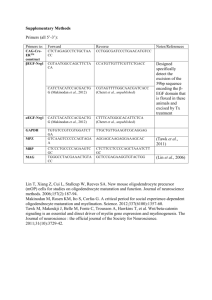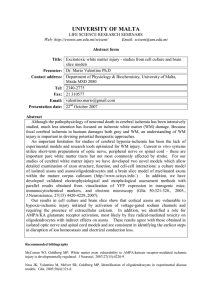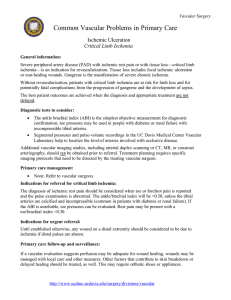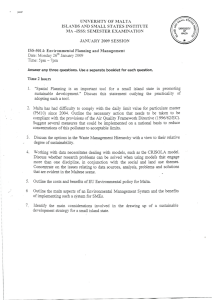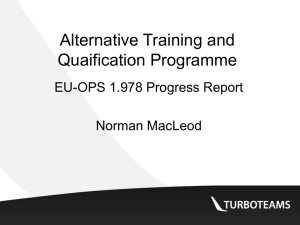Vulnerability of white matter to ischemia varies during development
advertisement
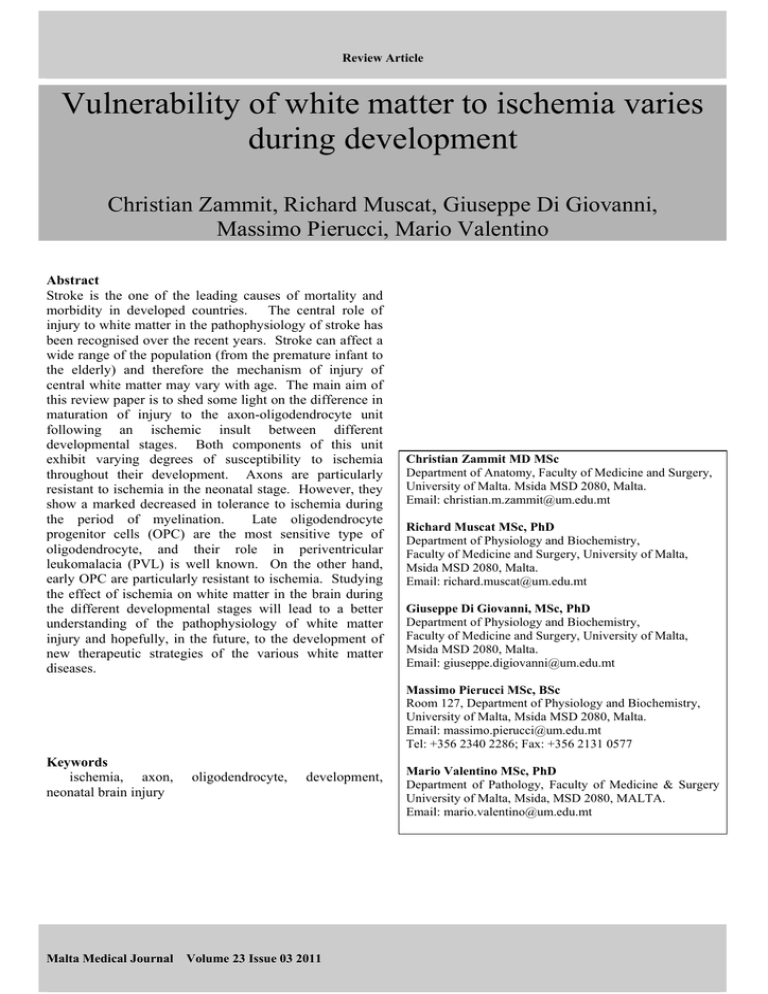
Review Article Vulnerability of white matter to ischemia varies during development Christian Zammit, Richard Muscat, Giuseppe Di Giovanni, Massimo Pierucci, Mario Valentino Abstract Stroke is the one of the leading causes of mortality and morbidity in developed countries. The central role of injury to white matter in the pathophysiology of stroke has been recognised over the recent years. Stroke can affect a wide range of the population (from the premature infant to the elderly) and therefore the mechanism of injury of central white matter may vary with age. The main aim of this review paper is to shed some light on the difference in maturation of injury to the axon-oligodendrocyte unit following an ischemic insult between different developmental stages. Both components of this unit exhibit varying degrees of susceptibility to ischemia throughout their development. Axons are particularly resistant to ischemia in the neonatal stage. However, they show a marked decreased in tolerance to ischemia during the period of myelination. Late oligodendrocyte progenitor cells (OPC) are the most sensitive type of oligodendrocyte, and their role in periventricular leukomalacia (PVL) is well known. On the other hand, early OPC are particularly resistant to ischemia. Studying the effect of ischemia on white matter in the brain during the different developmental stages will lead to a better understanding of the pathophysiology of white matter injury and hopefully, in the future, to the development of new therapeutic strategies of the various white matter diseases. Christian Zammit MD MSc Department of Anatomy, Faculty of Medicine and Surgery, University of Malta. Msida MSD 2080, Malta. Email: christian.m.zammit@um.edu.mt Richard Muscat MSc, PhD Department of Physiology and Biochemistry, Faculty of Medicine and Surgery, University of Malta, Msida MSD 2080, Malta. Email: richard.muscat@um.edu.mt Giuseppe Di Giovanni, MSc, PhD Department of Physiology and Biochemistry, Faculty of Medicine and Surgery, University of Malta, Msida MSD 2080, Malta. Email: giuseppe.digiovanni@um.edu.mt Massimo Pierucci MSc, BSc Room 127, Department of Physiology and Biochemistry, University of Malta, Msida MSD 2080, Malta. Email: massimo.pierucci@um.edu.mt Tel: +356 2340 2286; Fax: +356 2131 0577 Keywords ischemia, axon, neonatal brain injury Malta Medical Journal oligodendrocyte, development, Volume 23 Issue 03 2011 Mario Valentino MSc, PhD Department of Pathology, Faculty of Medicine & Surgery University of Malta, Msida, MSD 2080, MALTA. Email: mario.valentino@um.edu.mt Review Article Incidence of stroke Stroke is a leading cause of serious long-term disability in the world. According to World Health Organisation data 15 million people suffer from stroke worldwide yearly.1 Stroke is listed as being the second most common cause of death worldwide, and the leading cause of longterm disability in the United States.2 Stroke was long thought to be a disease that affects only the elderly, and stroke in neonates was considered a rare occurrence. However, the care of premature infants has improved significantly over the past years, resulting in a marked improvement of the survival of very low birth weight infants (< 1.5 kg). In the U.S. 1.5% of all births are very low birth weight (around 65,000 per year), and 90% of these survive the neonatal period.3 Sadly, around 10% of these survivors later develop spastic motor deficits (cerebral palsy)4 and around 25-50% later exhibit cognitive, attentional, behavioural, and/or socialisation defects that significantly impair their quality of life.5-6 Importance of white matter in stroke The traditional view that gray matter is the single contributing factor to the outcome of stroke has recently been challenged. Animal studies in the past showed that gray matter is more vulnerable than white matter.7 This might be due to the fact that most of the experimental work done on stroke utilised rodents as animal models. In rodents, white matter constitutes only 13% of total brain volume.8 Therefore, white matter injury was often overlooked and given less importance. However in humans, white matter accounts for almost 50% of total brain volume8, and the metabolic rate of white matter is only modestly reduced when compared to that of grey matter.9 Moreover, any ischemic stroke will affect similar proportions of grey and white matter, and it is never limited to gray matter alone. White matter injury in neonatal stroke Clinical interest in ischemic injury to developing white matter has recently increased considerably. Although the immature central nervous system (CNS) is regarded to be more resistant than the adult, it is now known that any ischemic insult between 23 and 32 weeks gestation can result in a remarkably selective pattern of injury known as PVL.10 In fact, PVL is the most common cause of brain injury in the premature infant.11 The pathogenesis of white matter injury in the neonate is different from that in the adult. Volpe and colleagues summarise the pathogenesis of PVL into three major interacting factors: cerebral ischemia, systemic infection and inflammation, and maturation-dependent intrinsic vulnerability of pre-myelinating oligodendrocytes.12 Malta Medical Journal Volume 23 Issue 03 2011 Myelination of the CNS and oligodendrocyte development Myelination of the CNS is a well-controlled and systematic process that occurs in an orderly spatial and temporal sequence (Fig 1). All CNS neurons are formed before birth, while white matter begins to from only in the third trimester of gestation.13 The process of white matter development is not complete at birth, and it is still only 90% complete by 2 years of age.14 In the neonate, myelination is restricted only to the basal ganglia, and sensory fibres passing up from the spinal cord. After birth, the tectospinal, corticospinal, corticobulbar, and corticopontocerebellar fibers begin to myelinate.15 Posterior regions of the brain myelinate prior to anterior regions.16 The last fibres to myelinate are the inter-cortical association neurons, while myelination in the frontal lobes occurs into adolescence and early adulthood.17 Figure 1 – Cycles of myelination in the CNS during development. The width and the length of graphs indicate progression in density of myelinated fibers; the vertical stripes at the end of the graphs indicate approximate age range of termination of myelination (taken from 1). Oligodendrocyte development can be characterised into four stages: early oligodendrocyte progenitor cells (OPC), late OPC (also called premyelinating oligodendrocytes), immature myelinating oligodendrocyte, and mature myelinating oligodendrocyte (Fig. 2).18 Early OPC are small bipolar cells that start forming around 13 weeks gestation in humans. They can be identified by the NG2 antigen. These cells differentiate into a simple multipolar, mitotically active late OPC at 20 week gestation. They are identified mainly with O4 antibodies but not with O1 (NG2 is still present at this stage). The immature myelinating oligodendrocyte is a postmitotic complex multipolar cell identified by the O1 antibody. The mature oligodendrocyte undergoes Review Article extensive cellular growth and process elaboration and is identified by a variety of myelin-associated markers that include myelin basic protein.19-23 Figure 2 – Oligodendrocytes lineage. Successive stages are characterised by increasingly complex morphology and by different antigenic marker (taken from 18) Axonal ischemic injury during development In the past, the CNS of the neonatal mammal was regarded to be more resistant to ischemia than that of the adult.24-25 Researchers proposed that this might be a safety mechanism of the neonate, since the neonatal brain is more prone than the adult to suffer from periods of hypoperfusion during the pre- and post-natal period.26-27 However, prolonged neonatal ischemia can result in extensive CNS injury, and some studies show that white matter structures are more vulnerable than gray matter during the neonatal period.28 The sensitivity of rat gray matter to anoxia and aglycemia increases progressively from birth to adulthood, consistent with the rise in metabolic rate.29 White matter do not follow a similar pattern. Fern and colleagues showed that neonatal white matter is very resistant to ischemia. Using optic nerves from neonatal mice (postnatal day 2 (P2)), they found that it is tolerant to anoxia, aglycaemia, and combined anoxia and aglycaemia in terms of maintenance of evoked compound action potential, and shows a good recovery of function during reperfusion (Fig. 3).30 We did a structural analysis of the OGD-induced damage to the optic nerve from a similar age group of mice, and confirmed such results (unpublished data) (Fig. 4). This tolerance to ischemia may be attributed to the lower metabolic rate of neonatal white matter.24,31 Malta Medical Journal Volume 23 Issue 03 2011 Figure 3 – The effect of 60 min OGD on the optic nerve compound action potential from rats of various ages. (A) Change in magnitude of CAP plotted against time after initiation of OGD 60 min; (B) extent of CAP recovery after 60 min OGD plotted against age (taken from 30) Figure 4 – Summary data for axonal injury. There is progression of injury following all lengths of OGD which was most prominent in P20-50 mice (squares). P <20 mice (diamond) were the most resistant to injury. * p < 0.001 (ANOVA) (unpublished data) Review Article In mice, there is a period of heightened sensitivity to ischemia from postnatal day 20 to 50. In fact, 60 mins of OGD induces a complete loss of CAP with no recovery of function in this age group (Fig. 3).30 Again, results from our experiments on the effect of ischemia on structural integrity of axons show that the degree of ischemia induced injury in this age group is higher than older and younger mice (unpublished data) (Fig. 4). This period of heightened sensitivity is dominated by the process of myelination. The rodent optic nerve starts myelination at around P7 with only few axons having just a single layer of myelin at this age.32 The rate of myelin deposition is maximal between P21 and P28, and from this point onward, the process of myelination is at its highest.33 Therefore, the period of low tolerance to ischemia found between P20 and P50, may be attributed to the heightened metabolic activity associated with the anabolic process of myelination.34-35 Besides myelination, other factors may contribute to this increases susceptibility to ischemic injury. The Na+ channel density in optic nerve axons varies with age: starting from < 2/µm2 in the neonate36, increases up to the age of around P25, followed by a decrease in adulthood.37 During myelination, these Na+ channels aggregate at the nodes of Ranvier, and the change in density of Na+ channels results in a persistent Na+ current, which exacerbates white matter injury following anoxia.38 Ca2+ currents increase in magnitude in the postnatal period39, and Ca2+ channels were shown to contribute directly to anoxic injury in white matter.40 The fact that ischemic damage is dependent on the white matter developmental stage, leads to another question. Is the mechanism of injury the same during the different stages? Tekkök and Goldberg showed that AMPA/Kainate receptor activation, and Ca2+ influx are essential in the maturation of axonal injury to white matter in adults. In fact, blocking of AMPA/Kainate receptors and Ca2+ removal from the perfusate preserves oligodendrocytes and axonal structure and function.41 On the other hand, McCarren and Goldberg found that in P3 mice, AMPA/Kainate receptor agonists do not damage axons, and antagonists do not prevent ischemic axonal damage (Fig 5). Similar results to those obtained by Tekkök and Goldberg (2001) were achieved by this group when older mice (older than postnatal day 20) were used. In this age group, AMPA exposure damages axons, and AMPA/Kainate blockade results in preservation of axonal structure (Fig 5). McCarren and Goldberg proposed that there might be some change in the intrinsic properties of oligodendrocytes and axons during this developmental stage.42 Figure 5 – Effect of AMPA agonists on P3 and P21 mice. AMPA agonists induced damage in P21 mice (B), but not in P3 mice (A) (taken from 42) Vulnerability of the various oligodendrocyte developmental stages to ischemia Oligodendrocyte are vulnerable to ischemia, and their sensitivity varies with each developmental stage. As discussed before, there are four stages of oligodendrocyte Malta Medical Journal Volume 23 Issue 03 2011 development: early OPC, late OPC, immature myelinating oligodendrocyte, and mature myelinating oligodendrocyte. Review Article Early OPC are the most resistant type to ischemia, with late OPC being the most sensitive.43 Back and colleagues used brain slices containing corpus callosum from P2 mice to study the relative susceptibility of early OPC, late OPC, and immature oligodendrocytes. After induction of OGD, early OPC appear hypertrophic, with thickened proximal processes, and a more elaborate process arbor (Fig 6 (A) arrowheads), thus confirming their resistance to ischemia. In contrast, following ischemia late OPC exhibit widespread degeneration (Fig 6 (A) arrows), and the density of pyknotic (dead) late oligodendrocyte progenitors is significantly higher than that of immature oligodendrocytes (Fig 6 (B)).43 This maturation-dependant sensitivity of late OPC to ischemia is one of main causes leading to preferential white matter injury in the neonate, i.e. to PVL12, since their development coincides with the high-risk period of PVL in humans.44 The major factors underlying the maturation-dependent susceptibility of the late OPC were summarised in a recent review paper by Volpe. Briefly, the abundant production of both reactive oxygen species and reactive nitrogen species during PVL, the delayed development of antioxidant defences in late OPC, and the acquisition of Fe2+ by late OPC result in vulnerability of this cell to free radical attack. Also, late OPC are very sensitive to excitotoxicity due to exuberant expression of the major glutamate transporter, of AMPA receptors deficient in the GluR2 subunit (and therefore Ca2+ permeable), and of NMDA receptors (which are also Ca2+ permeable).12 Figure 6 – Maturation-dependant vulnerability in oligodendrocyte lineage. (A) Numerous reactive early OPC (red, arrowheads) in ischemic lesion in P2 animals overlapped with pyknotic late OPC (green, arrows); (B) Comparing number of pyknotic (dead) late OPC and immature oligodendrocytes following OGD (taken from 43). Malta Medical Journal Volume 23 Issue 03 2011 Fern and Moller studied the remaining two groups of oligodendrocyte development stages, i.e. immature and mature oligodendrocyte, using cell cultures from P2 rats. Mature oligodendrocytes (A2B5– /GC+) are more resistant to ischemic damage than immature ones (O4+/GC–) (Fig 7). They proposed that the rapid ischemic cell death of the immature oligodendrocytes is mediated by Ca2+ influx via non-NMDA glutamate receptors, and is exacerbated by a significant element of autologous feedback of glutamate from cells onto their own receptors.45 Figure 7 – Comparing Mature (A2B¬5–/GC+) with immature (O4+/GC–) oligodendrocytes following OGD (taken from 45). Figure 8 – Summary data for percentage dead oligodendrocytes. The number of dead oligodendrocyte increased following all lengths of OGD with P < 20 mice (diamond) being most sensitive, and P > 50 mice (triangle) being most resistant to ischemic damage. * p< 0.05 (Chi-square test) (unpublished data) Review Article In our experiments, we compared the susceptibility of the immature and mature myelinating oligodendrocyte to various lengths of OGD (unpublished data) using the mouse optic nerve from different developmental stages. We used the APC antibody, which is directed against APC (adenomatous polyposis coli), an intracellular antigen on myelinating oligodendrocytes. We found that ischemia induces a higher percentage of dead APC positive oligodendrocyte (cells that were detected by APC antibody) in younger mice is higher than in older mice following the same ischemic insult (unpublished data) (Fig 8). Therefore, immature myelinating oligodendrocytes are more sensitive to OGD than the mature ones. Conclusions The period of increased tolerance to ischemia of white matter axons in mice coincides with the period of low metabolic demand in the unmyelinated axons present at that stage. In human CNS, the degree of myelination of axons is very limited at birth. The fact that unmyelinated axons seem to be more resistant to ischemia, might be advantageous to the neonate who is more prone to periods of hypoxia/ischemia than the adult. On the other hand, the period of heightened sensitivity, matches the myelination stage of mice axons. It would be interesting to investigate if myelinating axons in the human CNS are also more susceptible to ischemic injury than unmyelinated or fully myelinated axons. The hypothetical period of increased sensitivity of axons in humans would be present around the first two years of life. To our knowledge this was never documented in humans, and more studies on human subjects with childhood stroke are needed to investigate this theory. insights on developing new therapeutic modalities for such a challenging disease. References 1. 2. 3. 4. 5. 6. 7. 8. 9. 10. 11. 12. The maturation-dependent vulnerability of the late OPC to ischemic injury is one of the bases leading to PVL, and this fact is very well documented in literature. In view of the intricate relationship between axons and oligodendrocytes, one would expect that oligodendrocytes would show a similar pattern of vulnerability to axons, i.e. a heightened sensitivity to ischemia during the myelination stage. However, this was not the case, since in our study, we found that myelinating oligodendrocytes (detected with APC antibody) present in mice P<20 were more sensitive than their counterparts present during the myelination phase. This discrepancy was never documented in literature, and further studies needs to be conducted to elucidate the exact mechanism behind this difference. 13. 14. 15. 16. 17. 18. Considering all these facts, one appreciates the importance of research in this area. The pathophysiological mechanisms of white matter injury in stroke vary between different developmental stages. Understanding better these differences, might give new Malta Medical Journal Volume 23 Issue 03 2011 19. World Health Organisation. The world health report 2002 Reducing Risks, Promoting Healthy Life. Geneva: World Health Organisation; 2002 Murray CL and Lopez AD. Mortality by cause for eight regions of the world: global burden of disease study. The Lancet. 1997; 349, pp.1269–1276. Muglia LJ and Katz M. The enigma of spontaneous preterm birth. The New England Journal of Medicine. 2010; 11, pp.529-35. Doyle LW, Roberts G, Anderson PJ. Victorian Infant Collaborative Study Group. Outcomes at age 2 years of infants < 28 weeks' gestational age born in Victoria in 2005. Journal of Pediatrics. 2010; 156(1), pp.49-53. Msall ME. Central nervous system connectivity after extreme prematurity: understanding autistic spectrum disorder. Journal of Pediatrics. 2010; 156(4), pp.519-21. Johnson S, Fawke J, Hennessy E, Rowell V, Thomas S, Wolke D, et al. Neurodevelopmental disability through 11 years of age in children born before 26 weeks of gestation. Pediatrics. 2009; 124(2) pp.249-57. Marcoux FW, Morawetz RB, Crowell RM, DeGirolami U, Halsey JH. Differential regional vulnerability in transient focal cerebral ischemia. Stroke. 1982; 13, pp.339–346. Zhang K and Sejnowski TJ. A universal scaling law between gray matter and white matter of cerebral cortex. Proceedings of the National Academy of Sciences of the USA. 2000; 97, pp.5621–5626. Nishizaki T, Yamauchi R, Tanimoto M, Okada Y. Effects of temperature on the oxygen consumption in thin slices from different brain regions. Neuroscience Letters. 1988; 86, pp.301–305. Alix JJ. The pathophysiology of ischemic injury to developing white matter. McGill Journal of Medicine. 2006; 9(2), pp.134-140 Back SA and Rivkees S. Emerging Concepts in Periventricular White Matter Injury. Seminars in Perinatology. 2004; 28, pp.405-414 Volpe JJ, Kinney HC, Jensen FE, Rosenberg, PA. The developing oligodendrocyte: key cellular target in brain injury in the premature infant. International Journal of Developmental Neuroscience. 2011; 29(4), pp.423-440 Nolte J. The human brain. 4th ed. St Louis: Mosby; 1999 Byrd SE, Darling CF, Wilczynski MA. White matter of the brain: maturation and myelination on magnetic resonance in infants and children. Neuroimaging Clinics of North America. 1993; 3, pp.247-266 Snell RS. Clinical Neuroscience. 7th edition. Lippincott Williams & Wilkins; 2001 Hayakawa K, Konishi Y, Kuriyama M., Konishi K, Matsuda T. Normal brain maturation in MRI. European Journal of Radiology. 1991; 12(3), pp.208–215. Yakolev PI and Lecours AR. The myelogenic cycles of regional maturation of the brain. In: Minkowski, A. (Ed.), Regional Development of the Brain in Early Life (pp.3–70) Oxford:Blackwell Scientific Publications; 1967 Back SA. Perinatal white matter injury: the changing spectrum of pathology and emerging insights into pathogenetic mechanisms. Mental Retardation and Developmental Disabilities Research Reviews. 2006; 12(2), pp.129-140. Jakovcevski I and Zecevic N. Olig transcription factors are expressed in oligodendrocyte and neuronal cells in human Review Article 20. 21. 22. 23. 24. 25. 26. 27. 28. 29. 30. 31. 32. 33. fetal CNS. The Journal of Neuroscience. 2005; 25, pp.1006410073. Kessaris N, Fogarty M, Iannarelli P, Grist M, Wegner M, Richardson WD. Competing waves of oligodendrocytes in the forebrain and postnatal elimination of an embryonic lineage. Nature Neuroscience. 2006; 9, pp.173-179. Jakovcevski I, Filipovic R, Mo Z, Rakic S, Zecevic N. Oligodendrocyte development and the onset of myelination in the human fetal brain. Frontiers in Neuroanatomy. 2005; 3, pp.5. Silbereis JC, Huang EJ, Back SA, Rowitch DH. Towards improved animal models of neonatal white matter injury associated with cerebral palsy. Disease Models and Mechanisms. 2010; 3, pp.678688. Back SA, Riddle A, McClure MM. Maturation-Dependent Vulnerability of Perinatal White Matter in Premature Birth. Stroke. 2007; 38(2), pp.724-730. Duffy TE, Kohle SJ, Vannucci RC. Carbohydrate and energy metabolism in perinatal rat brain: relation to survival in anoxia. Journal of Neurochemistry. 1975; 24(2), pp.271-276. Kabat H. The greater resistance of very young animals to arrest of the brain circulation. American Journal of Physiology. 1940; 130, pp.588–599. Vannucci R. Experimental biology of cerebral hypoxia-ischemia: relation to perinatal brain damage. Pediatric Research. 1990; 27: 317–326, 1990. Volpe JJ. Brain injury in the premature infant–current concepts of pathogenesis and prevention. Biology of the Neonate. 1992; 62, pp.231–242. Paneth N, Rudelli R, Kazam E, Monte W. Brain Damage in the Preterm Infant. Cambridge: Cambridge University Press; 1994 Crépel V, Krnjev'c K, Ben Ari Y. Developmental and regional differences in the vulnerability of rat hippocampal slices to lack of glucose. Neuroscience. 1992; 47, pp.579–587. Fern R, Davis P, Waxman SG, Ransom BR. Axon Conduction and Survival in CNS White Matter During Energy Deprivation: A Developmental Study. Journal of Neurophysiology. 1998; 79, pp. 95-105 Hansen AJ. Effect of anoxia on ion distribution in the brain. Physiological Reviews. 1985; 65(1), pp.101-148. Foster RE., Connors BW, Waxman SG. Rat optic nerve: electrophysiological, pharmacological and anatomical studies during development. Brain Research. 1982; 255(3), pp.371-86. Skoff RP, Price DL, Stocks A. Electron microscopic autoradiographic studies of gliogenesis in rat optic nerve. II. Time of origin. The Journal of Comparative Neurology. 1976; 1 (169;3), pp.313-34 Malta Medical Journal Volume 23 Issue 03 2011 34. Davison AN and Dobbing J. Myelination as a vulnerable period in brain development. British Medical Bulletin. 1966; 22(1), pp.40-44. 35. Wiggins RC. Myelin development and nutritional insufficiency. Brain Research. 1982; 257(2), pp.151-75. 36. Waxman SG, Black JA, Kocsis JD, Ritchie JM. Low density of sodium channels supports action potential conduction in axons of neonatal rat optic nerve. Proceedings of the National Academy of Sciences of the USA. 1989 86(4), pp.1406-10. 37. Xia Y and Haddad GG. Postnatal development of voltagesensitive Na+ channels in rat brain. The Journal of Comparative Neurology. 1994; 8(345;2), pp.279-87. 38. Alzheimer C, Schwindt PC, Crill WE Postnatal development of a persistent Na+ current in pyramidal neurons from rat sensorimotor cortex. Journal of Neurophysiolg. 1993; 69(1), pp.290-292. 39. Lorenzon NM and Foehring RC Characterization of pharmacologically identified voltage-gated calcium channel currents in acutely isolated rat neocortical neurons. II. Postnatal development. Journal of Neurophysiology. 1995;73(4), pp.1443-1451. 40. Fern R, Ransom BR, Waxman SG. Voltage-gated calcium channels in CNS white matter: role in anoxic injury. Journal of Neurophysiology. 1995; 74(1), pp.369-377. 41. Tekkök SB and Goldberg M. AMPA/Kainate Receptor Activation Mediates Hypoxic Oligodendrocyte Death and Axonal Injury in Cerebral White Matter. The Journal of Neuroscience. 2001; 21(12), pp.4237–4248. 42. McCarren W. and Goldberg M. White Matter Axon Vulnerability to AMPA-Kainate Receptor-Mediated ischemic injury is developmentally regulated. The Journal of Neuroscience. 2007; 27(15), pp.4220–4229. 43. Back SA, Hee Han B, Ling Luo N, Chricton C, Xanthoudakis S, Tam J, et al. Selective Vulnerability of Late Oligodendrocyte Progenitors to Hypoxia–Ischemia. The Journal of Neuroscience. 2002; 22(2), pp. 455-463 44. Craig A, Ling Luo N, Beardsley DJ, Wingate-Pearse N, Walker DW, Hohimer AR et al. Quantitative analysis of perinatal rodent oligodendrocyte lineage progression and its correlation with human. Experimental Neurology. 2003; 181(2), pp.231-40. 45. Fern R and Moller T. Rapid Ischemic Cell Death in Immature Oligodendrocytes: A Fatal Glutamate Release Feedback Loop. The Journal of Neuroscience. 2000; 20(1), pp.34–42
